First Mobile Mast LIVE in Scotland’s Delayed 4G Infill Scheme UPDATE
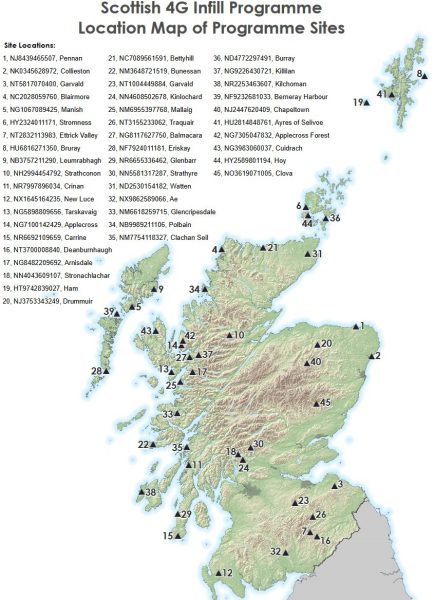
Good news, the Scottish Government‘s £25m 4G Infill Programme, which originally aimed to improve rural mobile coverage (mostly notspots across the Highlands and Islands) by building a network of 45 new masts for UK mobile operators to use (here), has finally built its first mast. Bad news, they’re well behind schedule.
Under the original plan construction – delivered by WHP Telecoms – was supposed to start toward the end of 2018 and then run for 4 years until the end of 2022, although today’s announcement states that “up to” 24 masts are now scheduled to be rolled out over the next two years (roughly half of what they originally expected to deliver by 2022). The remaining mast sites are merely said to still be “under consideration.”
In the meantime we have our first live mast (i.e. built and with active support from UK mobile operators) and able to serve residents around New Luce in Wigtownshire. At present only Vodafone are offering a 2G, 3G and 4G (mobile broadband) signal from this site, although EE (BT) are expected to follow “later this year” (there’s no word on Three UK or O2). EE will apparently also “provide service from a majority of sites in the programme.”
Advertisement
Paul Wheelhouse, Scottish Connectivity Minister, said:
“While telecommunications is a responsibility of UK ministers, improving mobile coverage is vital to achieving the Scottish Government’s ambition to make sure everyone in Scotland has access to high-speed, reliable coverage.
People in New Luce are the first to benefit but we hope that, like Wigtownshire, many more remote and rural parts of Scotland and Scotland’s islands will soon enjoy improved, cost-effective connectivity as a result of the Scottish Government’s work with industry and other partners, and our investment in the £25 million S4GI Programme.”
As for the reasons why the Scottish Government seems to be so far behind on their original plan, last year Paul Wheelhouse said (here), “The biggest challenge is trying to attract interest from mobile operators to actually utilise the masts.” Sadly he didn’t elaborate and the trade body Mobile UK was similarly coy when we questioned them.
However part of the issue could be related to a clash with the wider and similarly focused £1bn Shared Rural Network (SRN) plan, which has been in gestation for the past year or so. Mobile operators will have wanted to figure that out first before knowing how to fit everything together in their forward plans.
On the other hand the 4G Infill scheme also harbours shades of the UK Government’s somewhat failed £150m Mobile Infrastructure Project, which set out with grand ambitions to improve mobile coverage in rural notspots but only ended up building 75 of the promised 575 masts (here).
The MIP became bogged down by a mix of problems, from delays in getting planning permission (some communities were unhappy and protested), to challenges with securing wayleave agreements via many different landowners and the difficulty of getting both a good power supply and backhaul capacity to such remote locations. Building the mast is one thing, but making it operational is another ball game entirely.
Advertisement
UPDATE 21st Feb 2020
As usual there’s a little more to this news under the hood. One of our readers has pointed out that there’s been another big change because 26 out of the originally identified 45 sites have now been completely dropped from the programme, due to lack of interest from mobile operators (e.g. the sites at Bruray in Skerries).
However, it’s not all bad news because 16 new site “candidates” have been added back in for future consideration. You can see an updated map of this change here: https://www.gov.scot/publications/scottish-4g-infill-programme-map/ .
Mark is a professional technology writer, IT consultant and computer engineer from Dorset (England), he also founded ISPreview in 1999 and enjoys analysing the latest telecoms and broadband developments. Find me on X (Twitter), Mastodon, Facebook, BlueSky, Threads.net and Linkedin.
« Study Claims 20 Million UK Homes Hit by Broadband Speed Issues
Cityfibre Begins FTTH Broadband Rollout in Adur and Worthing »







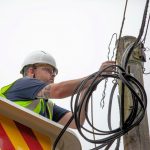
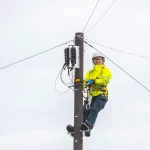

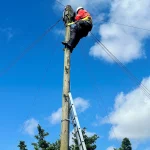

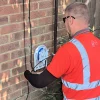










































The Strathconon mast is almost there
Mast built, power connected, fibre connected and antennae installed and ee confirmed network provider
Just missing the cabinets at the bottom of the mast to connect signal to/rom antennae
I’ve got photos if anyone wants to see them 🙂
Our delay has been caused by two things
1 – The mast will also be used for the ESN which seems to have slowed down decision-making (the mast, power and fibre connection were completed by September)
2 – Equipment availability which seems almost unbelievable
Sadly equipment availability is likely to get even worse in the coming months due to China virus factory shut downs.
They want independence I say let them have it – so they wont want the Government’s yearly 200M contribution will they.
Enjoy paying for it yourself
If you feel like being racist towards the Scottish on an unrelated article just leave and re-evaluate your life.
There is no point telling this fella anything. I’ve seen it on multiple occasions when Scotland is brought up. Brings up independence when he can. He’s set in his ways by the looks of it.
waste of braincells
Step forward, hopefully this will happen everywhere else, but I see landowners and nimbys putting a spanner in the works, there seems to be too many obstacles AONB, Conservation areas, health concerns, and objections to see it really improving some areas.
Most “health concerns” ought to be disregarded in the planning process as they are not valid grounds to object. Also, most have no scientific basis either, are mainly sourced from dodgy internet material by the gullible so should be set aside anyway.
Does anyone know how many houses are within the coverage area of the New Luce mast?
I am very interested to see how the commercial case pans out – I expect that the cost per house receiving new 4G mobile service is going to come in somewhere around the £5k mark, (around the same cost as the MIP deployments).
The other metric that is of interest here is the cost per square mile for new coverage. The predicted cost for the proposed Shared Rural Network (SRN) is around £250k per square mile – assuming that the players within the SRN project do manage to settle their difference *and* do manage to deploy all of the infrastructure that they are planning to….
£100000 if it’s that much to build? Here with the amount of properties which would get a signal equates to £55 per property. The amount of objections last mast planning application was the same as population of Wigtown over 900.
Ettrick Valley ( 7 ) almost completed. Fibre in…power on its way.
30 m . Mast…..thanks SCOTTISH Government!
No doubt you’ll be as appreciative of coverage gained in Scotland through the £1 billion SRN investment by the UNITED KINGDOM Government.
Yes , Gary we will be ! Good old BORIS.
The only snag is, we might not live long enough to see it.
Now all we need is R100 ,to start rolling out our FTTP. Happy days …
I’m up in LOT 1 , So a big shout out to Gigaclear, “Thanks a bunch”. Hopefully the other Lot’s see some progress.
Also as this thread is really 4G related it’ll be nice when we finally see some progress on that £1 billion SRN.
Either the Traquair mast has been operating since October last year or they don’t need an infill mast. I was at Traquair House for a Halloween event and had good 4G signal all day.
Yes, I thought Traquair got a decent signal from Innerliethen. The infill mast there not up yet, but they do have an Operator lined up., which seems to be a major problem for quite a few. Lots of ESN *4G EE masts going up……you wait 15 years for one mast, then half a dozen appear. That’s what happens when Government start paying for them.